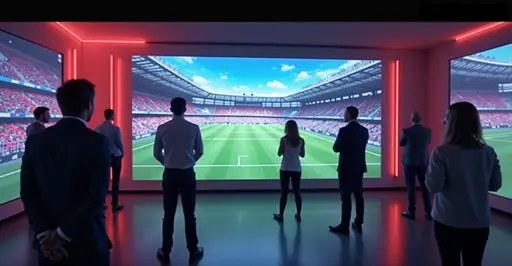AR and VR technologies are transforming stadium experiences with interactive games, real-time stats, and immersive replays, revolutionizing how fans engage with live sports events.

The New Era of Sports Entertainment
Sports stadiums are undergoing a technological transformation that's changing how fans experience live events. Augmented Reality (AR) and Virtual Reality (VR) technologies are creating immersive experiences that bridge the gap between physical attendance and digital engagement.
Immersive Stadium Experiences
Major sports franchises worldwide are investing heavily in AR and VR technologies to enhance the in-stadium experience. Companies like YinzCam have been at the forefront, developing mobile applications and AR experiences for over 170 sports properties including NFL clubs, NBA teams, and international football organizations.
"We're seeing a fundamental shift in how fans interact with live sports," says Priya Narasimhan, founder of YinzCam and Professor at Carnegie Mellon University. "AR technology allows fans to access real-time statistics, instant replays, and interactive games right from their seats."
Interactive Fan Engagement
The technology enables fans to point their smartphones at the field and see player statistics overlay in real-time. Virtual pop-a-shot games allow basketball fans to compete against each other on the video board, while interactive Hall of Fame experiences let football fans explore team history through AR interfaces.
Virtual Replay Technology
Virtual replay systems, first popularized during the 2006 FIFA World Cup, have evolved significantly. Today's systems use multiple 4K cameras shooting at 200 frames per second to create detailed 3D animations of key moments. This technology helps fans understand complex plays and officiating decisions better.
"The combination of virtual replay and virtual reality is creating unprecedented viewing experiences," notes a sports technology analyst. "Fans can now relive the most exciting moments from multiple angles, essentially becoming their own directors."
Future Stadium Developments
New stadiums like Everton's Hill Dickinson Stadium are being designed with technology integration in mind from the ground up. These venues are becoming technology hubs that offer seamless connectivity and interactive experiences throughout the facility.
Global Adoption
The trend isn't limited to North America. La Liga clubs in Spain, AFL teams in Australia, and sports organizations worldwide are implementing similar technologies. The global sports technology market is expected to continue growing as fans demand more interactive and personalized experiences.
As stadiums evolve into smart venues, the line between physical and digital fandom continues to blur, creating new opportunities for fan engagement and revenue generation for sports organizations.

 Nederlands
Nederlands
 English
English
 Français
Français
 Deutsch
Deutsch
 Español
Español
 Português
Português









